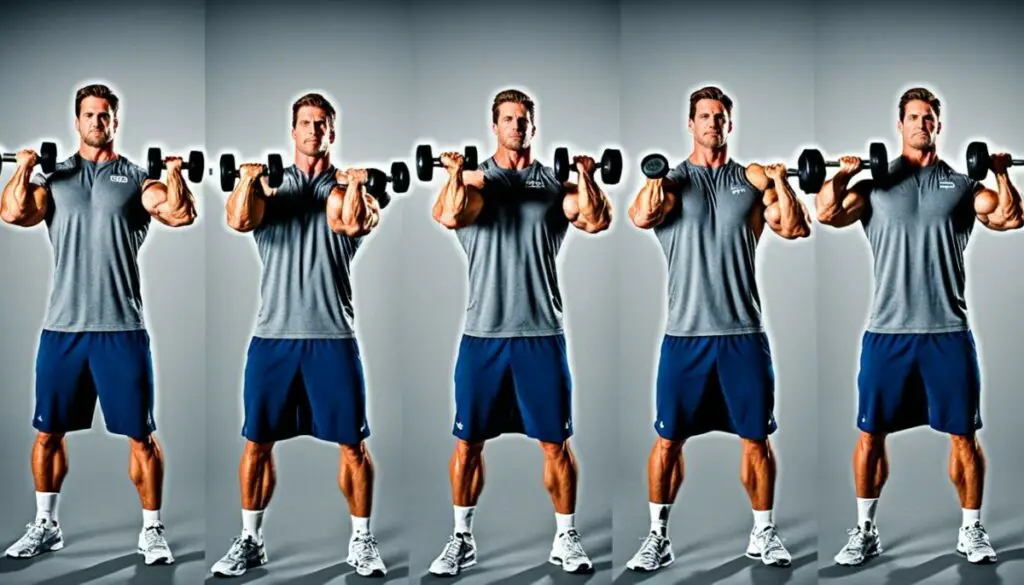Last Updated on 3 months by Francis
The dumbbell high pull is a compound exercise that can help you build strength and power while targeting multiple muscle groups. In this article, we will guide you through the proper technique of the dumbbell high pull, discuss the muscles it works, explore variations you can try, and highlight the benefits of incorporating this exercise into your workout routine.
Contents
Key Takeaways:
- The dumbbell high pull is a compound exercise that works your upper body and posterior chain muscles.
- It targets various muscles including the rhomboids, deltoids, latissimus dorsi, trapezius, biceps, triceps, lower back, abdominals, glutes, hip flexors, quadriceps, hamstrings, and calves.
- To perform the exercise correctly, maintain proper posture, engage the target muscles, and follow a specific technique, including explosive movements.
- There are variations of the dumbbell high pull that you can incorporate into your routine to add variety and challenge different muscle groups.
- Incorporating the dumbbell high pull into your workout routine offers benefits such as building strength, power, and improving functional fitness.
Muscles Worked by the Dumbbell High Pull

The dumbbell high pull is a compound exercise that engages various muscles in your upper body and posterior chain. By incorporating this exercise into your workout routine, you can effectively strengthen and develop these muscle groups:
- Rhomboids: Located between your shoulder blades, the rhomboids help retract and stabilize the scapulae.
- Deltoids: The deltoids are responsible for shoulder abduction and flexion.
- Latissimus Dorsi: The lats contribute to the extension, adduction, and internal rotation of the shoulder.
- Trapezius: The traps play a crucial role in scapular elevation, retraction, and depression.
- Biceps: The biceps are responsible for elbow flexion.
- Triceps: The triceps assist in elbow extension.
- Lower Back: The muscles in your lower back, such as the erector spinae, are engaged to maintain a stable trunk during the exercise.
- Abdominals: The abs help stabilize the core and assist in maintaining proper posture.
- Glutes: The glutes contribute to hip extension and stability.
- Hip Flexors: These muscles, including the psoas major and iliacus, assist in hip flexion during the exercise.
- Quadriceps: The quads play a role in knee extension as you elevate the dumbbells.
- Hamstrings: The hamstrings function to stabilize the knee joint during the exercise.
- Calves: The calf muscles, specifically the gastrocnemius and soleus, assist in maintaining balance.
By targeting these muscles, the dumbbell high pull provides a comprehensive full-body workout that helps improve strength, power, and muscular development.
Proper Technique for the Dumbbell High Pull

To perform the dumbbell high pull correctly, follow these steps:
- Start by standing with your feet hip-distance apart.
- Hold a dumbbell in each hand with an overhand grip.
- Hinge at your hips, keeping your back straight and abs engaged.
- Position the dumbbells just below your knees.
- Explosively raise the dumbbells as high as you can by fully extending your hips and knees.
- Raise your heels to come onto your tiptoes.
- Slowly lower the weights back to the starting position.
To get the most out of the dumbbell high pull, it is important to maintain proper posture and engage the target muscles throughout the exercise. Remember to keep your core tight and your back straight. Focus on using your hips and legs to generate the power for the movement.
“The dumbbell high pull is a compound exercise that targets multiple muscle groups and helps develop strength and explosive power,” says fitness expert, Sarah Smith. “It is a highly effective movement when performed with proper technique and can be incorporated into various workout routines.”
The dumbbell high pull is an excellent exercise for building strength and power in your upper body and posterior chain muscles. By mastering the proper technique, you can maximize the benefits of this compound movement and take your fitness to the next level.
Variations of the Dumbbell High Pull

Looking to add some variety to your workout routine? Incorporating variations of the dumbbell high pull can help you target different muscle groups and keep your workouts interesting. Here are a few examples to consider:
One-Arm Dumbbell High Pull
If you want to challenge your core and upper body stability, try performing the one-arm dumbbell high pull. Hold a single dumbbell in one hand and perform the high pull motion as usual. This variation helps improve unilateral strength and coordination.
Dumbbell High Pull to Overhead Press
Take your shoulder and arm strength to the next level by combining the dumbbell high pull with an overhead press. After performing the high pull, keep the dumbbells at shoulder height and press them overhead. This variation works the deltoids, triceps, and upper back muscles.
Squat to Dumbbell High Pull
Want to target your lower body while still reaping the benefits of the dumbbell high pull? Try incorporating the squat to dumbbell high pull into your routine. Begin with a squat, and as you drive upward, perform the high pull motion. This variation engages the quadriceps, hamstrings, glutes, and posterior chain muscles.
These are just a few examples of the many variations you can try with the dumbbell high pull. Feel free to get creative and experiment with different combinations to suit your fitness goals and preferences.
Remember to always focus on proper form and gradually increase the intensity as you become more comfortable with each variation. Keep challenging yourself and enjoy the variety and benefits that the dumbbell high pull can bring to your workouts!
Benefits of the Dumbbell High Pull

Incorporating the dumbbell high pull into your strength training routine offers numerous benefits. This exercise targets the upper body and posterior chain muscles, providing a comprehensive workout that builds strength and power in multiple areas.
The explosive movement involved in the dumbbell high pull not only helps develop muscular strength but also improves functional fitness. By training your body to generate force quickly, you enhance your ability to perform explosive movements in sports and everyday activities.
Unlike isolated exercises that focus on specific muscle groups, the dumbbell high pull activates multiple muscles simultaneously. This makes it a time-efficient exercise that provides a comprehensive workout in a shorter period. By engaging various upper body and posterior chain muscles, including the deltoids, trapezius, biceps, and glutes, it helps improve overall muscle coordination and balance.
“The dumbbell high pull is a dynamic exercise that engages multiple muscle groups, making it a highly effective compound movement for building strength and power.”
| Dumbbell High Pull Benefits |
|---|
| Builds strength and power in the upper body and posterior chain muscles |
| Improves functional fitness and the ability to generate force quickly |
| Activates multiple muscle groups simultaneously for a time-efficient workout |
| Enhances overall muscle coordination and balance |
By incorporating the dumbbell high pull into your workout routine, you can experience these benefits and take your strength training to the next level.
Precautions and Considerations for the Dumbbell High Pull

When performing the dumbbell high pull, it’s essential to prioritize safety and take certain precautions. Here are some important considerations to keep in mind:
- Start with a low weight load: For beginners or individuals unfamiliar with the exercise, it’s crucial to begin with a manageable weight load. This approach allows you to focus on maintaining proper form and technique without compromising your safety.
- Gradually increase the intensity: As you become more comfortable with the dumbbell high pull and perfect your form, you can gradually increase the intensity by adding more weight. This progressive approach helps minimize the risk of injury and ensures a gradual strength build-up.
- Use a spotter when necessary: If you plan to lift heavy weights or push the limits of your capabilities, having a spotter nearby can offer an extra layer of safety and support. The spotter can provide assistance if you struggle with the movement or encounter any difficulties.
- Wear proper footwear: Opt for athletic shoes with good stability and grip when performing the dumbbell high pull. These shoes provide the necessary support and traction, enhancing your stability and minimizing the risk of slips or falls.
- Listen to your body: Pay attention to any discomfort or pain that arises during or after the exercise. If you experience acute or persistent pain, or develop any injuries, it’s important to stop the exercise and seek medical attention. Ignoring pain signals can exacerbate existing issues and hinder your progress.
For beginners, it’s crucial to focus on mastering the proper technique before adding weight or attempting advanced variations. This approach allows you to build a solid foundation and gradually progress to more challenging exercises.
Remember, safety should always be a top priority when engaging in any exercise. By taking the necessary precautions and heeding your body’s signals, you can confidently incorporate the dumbbell high pull into your workout routine and reap its many benefits.
Incorporating the Dumbbell High Pull into Your Workout Routine
The dumbbell high pull is a versatile exercise that can be seamlessly integrated into your strength training or full-body workout routine. Whether you’re looking for a warm-up exercise before explosive moves or a standalone exercise to target specific muscle groups, the dumbbell high pull has got you covered.
When incorporating the dumbbell high pull into your routine, aim for 2 to 5 sets of 2 to 6 repetitions, depending on your fitness level and goals. Start with lighter weights and gradually increase the intensity as you build strength and confidence. Remember to prioritize proper form and engage your target muscles throughout the exercise.
Pro tip: Allow your muscles at least 24 hours of rest before targeting them again to ensure proper recovery and avoid overtraining.
“The dumbbell high pull is one of my go-to exercises for explosive power. It engages multiple muscle groups and helps strengthen my upper body and posterior chain. I love incorporating it into my full-body workouts to add an extra challenge and make the most of my training time.” – Sarah, fitness enthusiast
Variations to Spice Up Your Routine
To keep your workouts interesting and continue challenging your muscles, you can try different variations of the dumbbell high pull. Here are a few options:
- One-arm dumbbell high pull: Perform the exercise using one arm at a time, alternating between sides.
- Dumbbell high pull to overhead press: Combine the dumbbell high pull with an overhead press to target your shoulder muscles.
- Squat to dumbbell high pull: Incorporate the squat movement into the exercise for an extra lower body challenge.
By experimenting with these variations, you can engage additional muscle groups and add diversity to your routine, helping you achieve well-rounded strength and overall fitness.
Tracking Progress and Setting Goals
As with any exercise, tracking your progress is crucial for consistent improvement. Consider using a fitness journal or a specialized app to record your dumbbell high pull workouts. Track the weight load, sets, and repetitions, and note any PRs (personal records) or improvements over time. Celebrate your milestones and set new goals to keep pushing yourself forward.
Remember, progress may be gradual, but each step forward is a testament to your hard work and dedication.
Visualization of a Sample Workout Routine
Here’s an example of how you can incorporate the dumbbell high pull into a full-body workout routine:
| Exercise | Sets | Repetitions |
|---|---|---|
| Dumbbell High Pull | 4 | 4-6 |
| Bench Press | 3 | 8-10 |
| Squat | 3 | 8-10 |
| Overhead Press | 3 | 8-10 |
| Chin-ups | 3 | 6-8 |
| Plank | 3 | 30-60 seconds |
Note that this is just one example, and you can customize it based on your specific goals, preferences, and fitness level.
Now that you know how to incorporate the dumbbell high pull into your workout routine, it’s time to grab those weights, focus on your form, and unleash your true potential!
Progression and Tracking with the Dumbbell High Pull
Progressing in your dumbbell high pull exercise is crucial to continue challenging your muscles and making gains. There are two primary ways to progress with the dumbbell high pull: increasing the weight load and adjusting the sets and repetitions. By combining these methods and tracking your progress, you can consistently improve and maximize the benefits of this exercise.
Increasing Weight Load
One way to progress with the dumbbell high pull is by gradually increasing the weight load. As you become more comfortable with the exercise and your muscles adapt, it’s essential to challenge them with heavier dumbbells. Start by adding small increments of weight, such as 2-5 pounds, and gradually work your way up as your strength improves. Remember to maintain proper form and technique even with the increased load to avoid injuries.
Adjusting Sets and Repetitions
Another way to progress is by adjusting the number of sets and repetitions you perform. For example, if you initially started with 2 sets of 6 repetitions, you can gradually increase it to 3 sets of 8 repetitions or even 4 sets of 10 repetitions. The additional volume will stimulate your muscles further and promote growth. However, ensure that you’re still able to maintain proper form and execute each repetition with control and focus.
Tracking your progress is essential to monitor your strength gains and ensure consistent improvement. Consider using a fitness journal or a fitness tracking app to record your dumbbell high pull workouts. Note down the weight used, number of sets and repetitions, and any other relevant details. By documenting your progress, you can visually see how far you’ve come and identify areas where you can push yourself further.
Remember to set realistic goals and challenge yourself during each workout. Pushing beyond your comfort zone is key to continuous progress. However, always listen to your body and avoid overtraining or pushing yourself to the point of exhaustion. Rest and recovery are just as important as the workout itself for muscle growth and overall fitness.
| Week | Weight Load (lbs) | Sets x Repetitions |
|---|---|---|
| 1 | 10 | 2×6 |
| 2 | 12 | 3×6 |
| 3 | 15 | 3×8 |
| 4 | 17.5 | 4×8 |
| 5 | 20 | 4×10 |
Common Questions and Answers about the Dumbbell High Pull
Here are some common questions and answers about the dumbbell high pull exercise:
Q: Is the dumbbell high pull suitable for beginners?
A: The dumbbell high pull can be challenging for beginners due to its explosive nature and the involvement of multiple muscles. It is recommended to start with lighter weights and focus on mastering the proper technique before progressing to heavier loads or advanced variations.
Q: What muscles does the dumbbell high pull target?
A: The dumbbell high pull targets various muscles, including the deltoids, trapezius, rhomboids, biceps, triceps, lower back, abdominals, glutes, hip flexors, quadriceps, hamstrings, and calves. It is a compound exercise that engages both the upper body and posterior chain.
Q: How many sets and reps should I perform?
A: The number of sets and reps can vary depending on your fitness goals and current fitness level. It is generally recommended to perform 2 to 5 sets of 2 to 6 repetitions with proper form and technique. Adjust the weight load accordingly to maintain the desired intensity.
Q: Can I incorporate the dumbbell high pull into a full-body workout?
A: Absolutely! The dumbbell high pull can be a great addition to a full-body workout routine. It can be used as a warm-up exercise before performing more advanced explosive moves or as a standalone exercise to target specific muscle groups. Remember to give your muscles adequate rest and recovery time between workouts.
Q: What are the benefits of the dumbbell high pull?
A: Incorporating the dumbbell high pull into your workout routine offers numerous benefits. It helps build strength and power in the upper body and posterior chain muscles. The explosive movement involved in the exercise improves functional fitness and trains your body to generate force quickly. Additionally, it engages multiple muscle groups simultaneously, making it a time-efficient exercise.
Q: Are there any precautions I should take when performing the dumbbell high pull?
A: Like any exercise, it’s important to take precautions when performing the dumbbell high pull. Start with a low weight load to ensure proper form and gradually increase the intensity. Use a spotter when necessary and wear proper footwear for stability. If you experience pain or develop injuries, stop the exercise and seek medical attention.
Q: How can I progress with the dumbbell high pull?
A: To progress with the dumbbell high pull, you can gradually increase the weight load or the number of sets and repetitions. It is essential to track your progress using a journal or fitness app to monitor your strength gains and ensure consistent improvement. Setting goals and challenging yourself will help you continue making progress and reaping the benefits of this exercise.
| Dumbbell High Pull FAQ Summary |
|---|
| Is the dumbbell high pull suitable for beginners? |
| What muscles does the dumbbell high pull target? |
| How many sets and reps should I perform? |
| Can I incorporate the dumbbell high pull into a full-body workout? |
| What are the benefits of the dumbbell high pull? |
| Are there any precautions I should take when performing the dumbbell high pull? |
| How can I progress with the dumbbell high pull? |
Conclusion
In conclusion, the dumbbell high pull is a highly effective exercise that can take your fitness routine to the next level. By incorporating this compound movement into your workouts and mastering the proper technique, you can build strength, power, and explosiveness.
The dumbbell high pull targets multiple muscle groups, including the upper body and posterior chain, making it a time-efficient exercise. Whether you’re a beginner or an advanced gym-goer, starting with a low weight load and gradually increasing intensity will help you progress and prevent injuries.
Remember to stay consistent with your training and track your progress. By recording your sets, repetitions, and weight load, you can monitor your strength gains and ensure consistent improvement. With dedication and perseverance, you’ll soon experience the benefits of incorporating the dumbbell high pull into your workout routine.
So, don’t miss out on the opportunity to challenge yourself and enhance your overall fitness. Add the dumbbell high pull to your strength training regimen and enjoy the rewards of increased strength, power, and mobility. Get ready to take your workouts to new heights with this dynamic exercise. Start today and unleash your full potential!
FAQ
What muscles does the dumbbell high pull work?
The dumbbell high pull targets various muscles in your upper body and posterior chain, including the rhomboids, deltoids, latissimus dorsi, trapezius, biceps, triceps, lower back, abdominals, glutes, hip flexors, quadriceps, hamstrings, and calves.
How do I perform the dumbbell high pull correctly?
Start by standing with your feet hip-distance apart, holding a dumbbell in each hand with an overhand grip. Hinge at your hips, keeping your back straight and abs engaged. Position the dumbbells just below your knees. Then, explosively raise the dumbbells as high as you can, fully extending your hips and knees. Raise your heels to come onto your tiptoes. Slowly lower the weights back to the starting position.
What are some variations of the dumbbell high pull?
Some variations of the dumbbell high pull include the one-arm dumbbell high pull, dumbbell high pull to overhead press, and squat to dumbbell high pull. These variations allow you to target different muscle groups and add variety to your workouts.
What are the benefits of incorporating the dumbbell high pull into my workout routine?
Incorporating the dumbbell high pull into your routine can help build strength, power, and explosiveness in your upper body and posterior chain muscles. The exercise improves functional fitness, trains your body to generate force quickly, and activates multiple muscle groups simultaneously.
Are there any precautions I should take when performing the dumbbell high pull?
Beginners should start with a low weight load and focus on mastering proper technique before adding weight or trying advanced variations. It’s important to use a spotter when necessary and wear proper footwear. If you experience pain or develop injuries, stop the exercise and seek medical attention.
How can I incorporate the dumbbell high pull into my workout routine?
You can incorporate the dumbbell high pull into your strength training or full-body workout routine. It can be used as a warm-up exercise before performing more advanced explosive moves or as a standalone exercise to target specific muscle groups. Aim for 2 to 5 sets of 2 to 6 repetitions, depending on your fitness level and goals.
How can I progress with the dumbbell high pull?
To progress with the dumbbell high pull, you can gradually increase the weight load or the number of sets and repetitions. It is essential to track your progress using a journal or a fitness app to monitor your strength gains and ensure consistent improvement.
What are some common questions about the dumbbell high pull?
Some common questions about the dumbbell high pull include: What other exercises can I combine with the dumbbell high pull? Can I do the dumbbell high pull if I have lower back issues? How many times per week should I incorporate the dumbbell high pull into my workouts?








